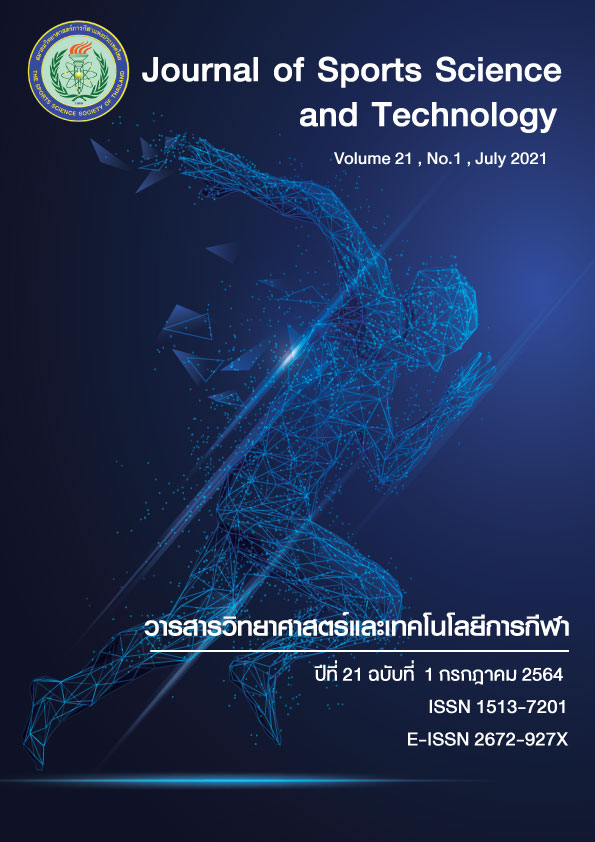PREDICTION OF BENCH PRESS ONE REPETITION MAXIMUM USING AN ACCELEROMETER
DOI:
https://doi.org/10.14456/jsst.2021.3Keywords:
One Repetition Maximum, Bench Press, Muscle Strength, Velocity Based TrainingAbstract
The purpose of this study was 1) to develop a predictive equation for calculating bench press one repetition maximum (1RM) via measurement of lifting velocity using accelerometry, and 2) subsequently test the validity of the predictive equation. A total of 31 healthy males (age ranged 18-35 years) who regularly performed resistance training and bench press exercise for at least 6 months were recruited. The anthropometric data of each participant were collected prior to the participants having their 1RM of a bench press assessed using both direct (NSCA protocol) and indirect (load-velocity relationship using accelerometer) methods. Linear regression was performed to establish the relationship between barbell velocities and the distinct 1RM percentages. To validate the actual 1RM (direct method) and predicted 1RM (indirect method) methods, a paired t-test was employed to compare the two methods. Pearson's correlation coefficients and the Coefficients of determination (R2) between the actual 1RM and predicted 1RM were calculated. Bland-Altman's method was used to evaluate the agreement between the actual 1RM and the predicted 1RM estimated. The obtained equation from the load-velocity relationship was: y = -80.53x + 113.35; R² = 0.869; where y represents the percentage of RM and x represents the measured velocity during the 1RM attempt. This relationship was used to formulate a predictive 1RM equation as follows: 1RM = 100 x (load /% RM); where load is defined as weight used during the concentric contraction phase by using an average of 3 repetitions. The predictive equation was found to have high validity (R2 = 0.89) compared to the direct method. The agreement between the different measurement methods was assessed using a Bland-Altman plot, and demonstrated the obtained 1RM values of the predictive equation to be within the upper and lower limits of agreement (LOA). Therefore, it is concluded that the predictive equation possessed high validity and can be used to accurately calculate 1RM. It is expected that the predictive equation may be used to assist sport practitioners and clinicians in the design and monitoring of resistance training programs.
(Journal of Sports Science and Technology 2021; 21(1):34-44)
(Received: 21 May 2021, Revised: 8 June 2021, Accepted: 8 June 2021)
Keywords: One Repetition Maximum/ Bench Press/ Muscle Strength/ Velocity Based Training
*Corresponding Author: Saiphon KONGKUM
College of Sports Science and Technology, Mahidol University.
Nakhon Pathom, Thailand. 73170. 094-552-1345
E-mail: saiphon.kon@mahidol.ac.th






